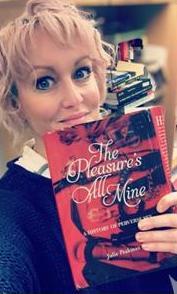Dr. Kate Lister runs the wonderful, informative and entertaining Whores of Yore Twitter account, and when she recently decided to start a website to go with it I invited her to tell my readers about it. Kate’s mission is much the same as mine: to demystify and destigmatize sex work by improving communication between sex workers and the general public.
 Last month, on International Day to End Violence Against Sex Workers (2016), I launched the Whores of Yore website; it was the culmination of a year’s hard work on a wonderful project that took me completely unawares. Whores of Yore grew out of a Twitter feed, that grew out of a research project on medieval sexuality, that grew out of a PhD into women and medievalism. I am a post-doctoral researcher at Leeds Trinity University (UK) and was reading into medieval attitudes surrounding sexual sin, when I found a London court record from 1340 of two “notorious strumpets”; Alice Strumpette and Clarice la Claterballock. I thought that was just wonderful. The wry wit in the aliases made me laugh, as I am sure they were supposed to. But, beyond being funny, the fact that such names would be adopted said more about sex work in the fourteenth century then many academic texts I have read; there was a real humanity to it. I started the Twitter feed @WhoreofYore to share snapshots of history like that.
Last month, on International Day to End Violence Against Sex Workers (2016), I launched the Whores of Yore website; it was the culmination of a year’s hard work on a wonderful project that took me completely unawares. Whores of Yore grew out of a Twitter feed, that grew out of a research project on medieval sexuality, that grew out of a PhD into women and medievalism. I am a post-doctoral researcher at Leeds Trinity University (UK) and was reading into medieval attitudes surrounding sexual sin, when I found a London court record from 1340 of two “notorious strumpets”; Alice Strumpette and Clarice la Claterballock. I thought that was just wonderful. The wry wit in the aliases made me laugh, as I am sure they were supposed to. But, beyond being funny, the fact that such names would be adopted said more about sex work in the fourteenth century then many academic texts I have read; there was a real humanity to it. I started the Twitter feed @WhoreofYore to share snapshots of history like that.
I had not foreseen any interest in the feed, but very quickly the followers grew and online articles began to be published about the content. I started getting feedback from followers who were reacting to the material I was posting in ways I could have never predicted. Twitter is a great leveller; your voice is on an equal footing with everyone else, and the feedback is instant. In the beginning, getting daily, uncensored and anonymous feedback about your work is daunting, but I learnt to listen, to respond and serve. I do get trolled, but follower feedback also made the feed better; it encouraged me to break away from a western focus, include more trans voices and bring in a daily dose of #HistoricalHottie (photographs of handsome men from history to balance up the eye-candy on offer). But, what changed my research was that Twitter allowed me to engage directly with the sex worker community. Suddenly, the history I was researching was no longer dead and buried; it was correcting my terminology on Twitter, and calling me a cunt when I got things wrong. Without realising it, I had been guilty of viewing sex work only through a historical, academic lens; it wasn’t real to me. But when a sex worker from Australia made contact with me to say she enjoyed the feed, but please could I stop using the word “prostitute” and use “sex worker” instead, I finally got it. History is powerful because it frames contemporary debate, but it is not to be archived away and accessible only to (well meaning) academics; it should engage with lives today. I was using the word “prostitute” in a clinical, academic way, but that perpetuated narratives that exists outside of historical research and the ivory tower. That was the moment that I saw a project that could make history relevant to contemporary issues. I wanted @WhoresofYore to facilitate an active process of feedback, reciprocal communication and attribution between sex workers, historians, activists, and anyone else who had a view to express.
made contact with me to say she enjoyed the feed, but please could I stop using the word “prostitute” and use “sex worker” instead, I finally got it. History is powerful because it frames contemporary debate, but it is not to be archived away and accessible only to (well meaning) academics; it should engage with lives today. I was using the word “prostitute” in a clinical, academic way, but that perpetuated narratives that exists outside of historical research and the ivory tower. That was the moment that I saw a project that could make history relevant to contemporary issues. I wanted @WhoresofYore to facilitate an active process of feedback, reciprocal communication and attribution between sex workers, historians, activists, and anyone else who had a view to express.
As sex workers are stigmatised, often criminalized people, historically, they have had little opportunity to speak without intermediaries. Rather, their stories and voices have been assumed by journalists, activists, and academics (like myself – the irony is not lost on me). However, with the advent of social media platforms, this is rapidly changing; social media has allowed sex workers a public voice, a space to engage with those speaking for them and about them, like never before. Online sex worker communities have been formed, alliances made and agendas set. “Nothing about us without us” is the mantra of the sex worker rights movement; the web and social media provide a platform for the sex worker voice to be heard, and invited academics to genuinely listen to the group they research. I wanted to build on this dynamic with a website and further bridge the gap between academic, historical research, and the sex worker voice; I hoped the website would create a space that enabled a process of democratisation and facilitate a discussion, rather than a lecture into the study and history of sexuality.
I wanted the website to feature articles on the history of sexuality and sex workers, but to retain an emphasis on sexuality and contemporary voices. To that end, I created a several article sections: sex history, sex talk, sex worker voices, LGBT History, politics and the law and an interactive timeline of sex workers throughout history. I put out a call for article submissions on the Twitter feed, and articles started to roll in. I have been extremely fortunate and BASIS Yorkshire (a charity who work with street sex workers and some of the most vulnerable members of the sex work community) have agreed to write a monthly blog about their work. BASIS is very private and protective of the people they work with, so to be able to facilitate a space for them is a real honor. I also have a sex therapist, Drew Lawson, who is regularly blogging on the site and answering all kinds of questions about sexuality. I work with the archivist at Delta of Venus, the web’s largest collection of vintage erotica, to bring a selection of historical pornographic images.
 But, this is only the beginning. So far, the project has been entirely self-funded, but I am looking into investment to grow. The project will expand to include podcasts, vlogging and interviews with historians, activists, members of the sex work community, and those who feel they are marginalised by their sexuality. The history of sexuality will be placed side by side with sexuality today in the hope we can join up some of those conversations. The purpose of this archive is not to create a goldfish bowl for others to stare into, but to provide a platform and invite people to share their experience and story; if you have an article to bring to the conversation, please email me. Shame and stigma are broken down through conversation, and when we listen to one another; I hope that’s what this project can play a part in. As Shannon L. Alder once wrote, “Never be ashamed of who you are. True shame always belongs to the person that enjoys being ashamed of who you are.”
But, this is only the beginning. So far, the project has been entirely self-funded, but I am looking into investment to grow. The project will expand to include podcasts, vlogging and interviews with historians, activists, members of the sex work community, and those who feel they are marginalised by their sexuality. The history of sexuality will be placed side by side with sexuality today in the hope we can join up some of those conversations. The purpose of this archive is not to create a goldfish bowl for others to stare into, but to provide a platform and invite people to share their experience and story; if you have an article to bring to the conversation, please email me. Shame and stigma are broken down through conversation, and when we listen to one another; I hope that’s what this project can play a part in. As Shannon L. Alder once wrote, “Never be ashamed of who you are. True shame always belongs to the person that enjoys being ashamed of who you are.”
